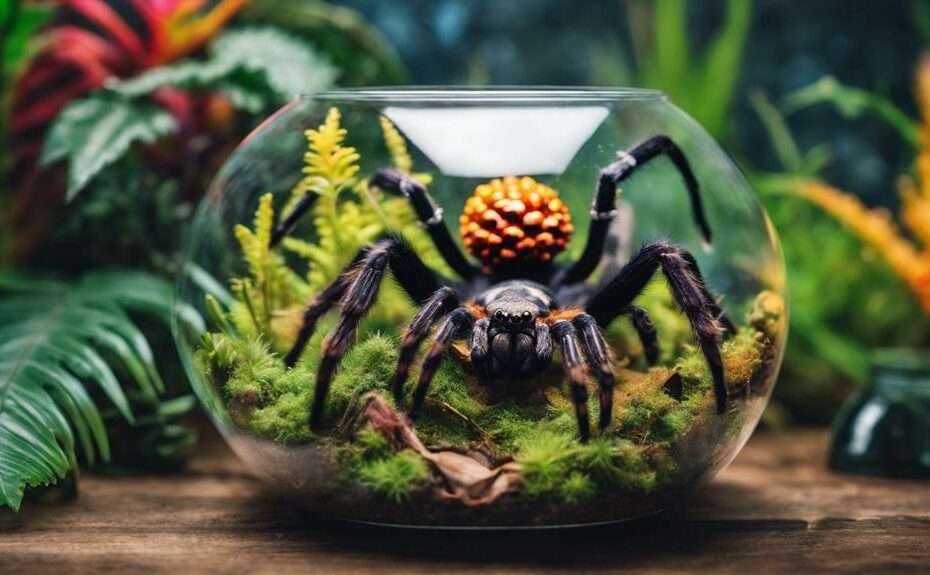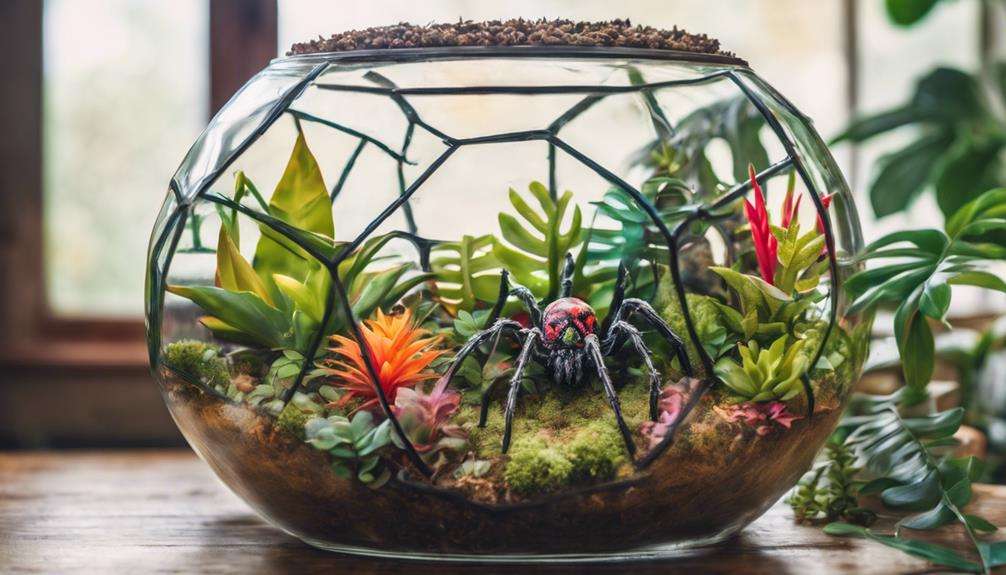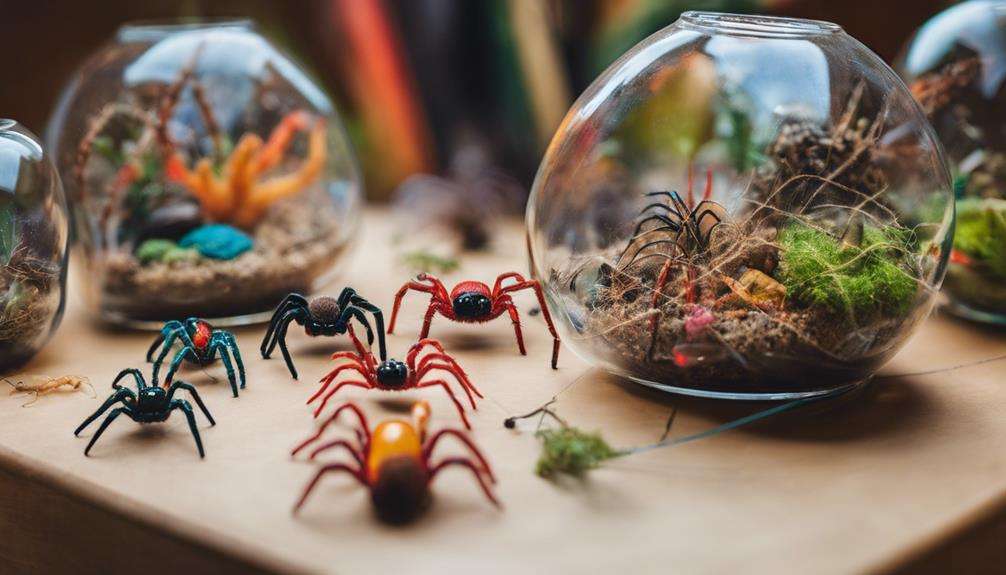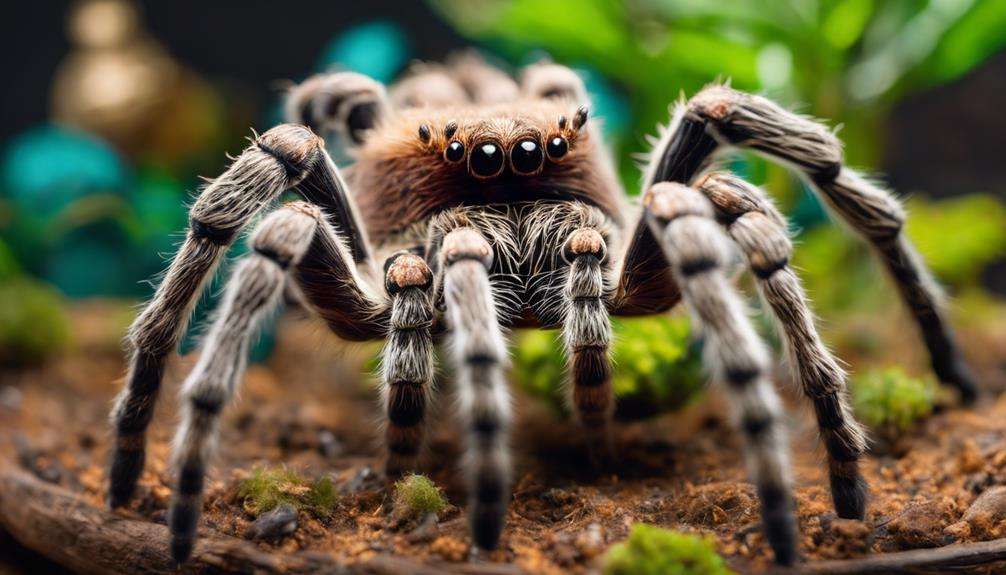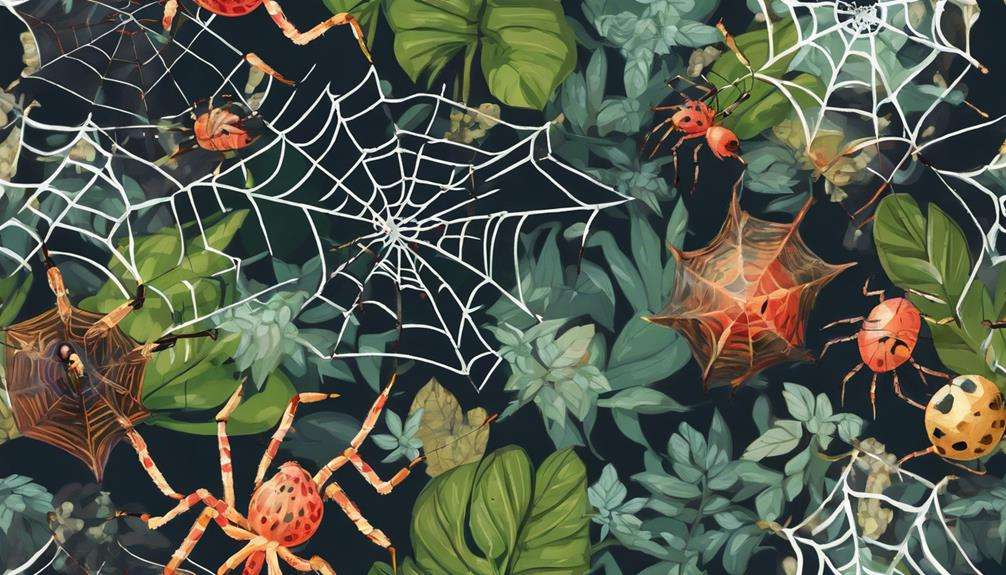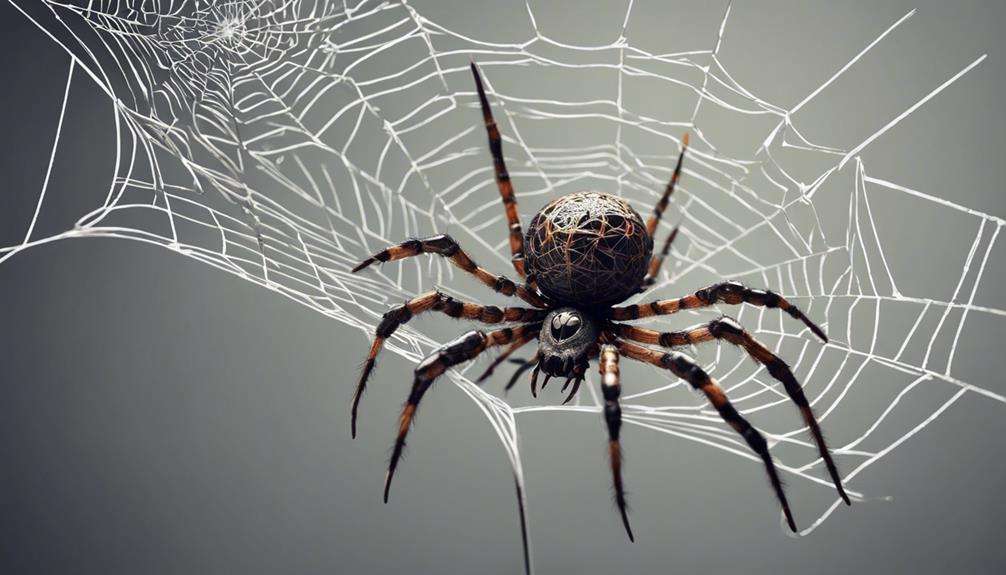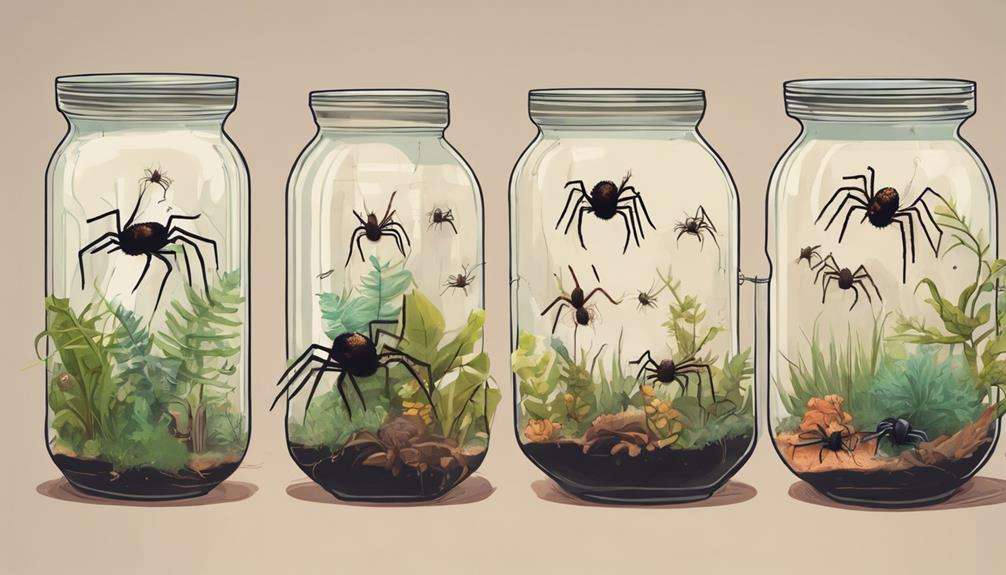Have you ever considered the idea that a pet spider could be an intriguing addition to your household?
While some may find the thought unsettling, there are compelling reasons to explore this unconventional pet choice.
The unique characteristics and benefits that spiders offer might surprise you, making them a fascinating option for those seeking a different kind of companion.
Key Takeaways
- Pet spiders are low-maintenance, long-lived companions suitable for small spaces.
- Owning a spider can help overcome arachnophobia and provide budget-friendly companionship.
- Unique spider species like Mexican Redleg and Green Bottle Blue offer striking appearances.
- Essential care tips include maintaining humidity, feeding live insects, and avoiding unnecessary handling.
Benefits of Having a Pet Spider
Having a pet spider offers numerous advantages that cater to individuals seeking a low-maintenance and long-term companion with budget-friendly requirements. Pet spiders, particularly tarantulas, are known for their low maintenance needs, requiring minimal attention compared to traditional pets. These fascinating creatures have a surprisingly long lifespan, with some species living up to 15-20 years, providing a lasting companionship.
Additionally, owning a pet spider can aid in overcoming arachnophobia, helping individuals develop a deeper appreciation and understanding of these often misunderstood animals. Tarantulas, in particular, are considered budget-friendly pets, as they've low upfront costs for setup and minimal recurring expenses for feeding. Besides, spiders require minimal space, only necessitating a small terrarium, making them suitable for individuals living in small apartments or houses.
Unique Spider Species to Consider
Consider exploring the fascinating world of unique spider species, each offering distinct characteristics and traits that cater to various preferences and levels of experience in spider keeping.
The Mexican Redleg tarantula is renowned for its striking appearance and docile nature, making it an alluring choice for enthusiasts.
For those seeking a hardy and low-maintenance option, the Brazilian Black tarantula stands out.
If an arboreal lifestyle appeals to you, the Pink Toe tarantula with its colorful pink feet might be the perfect fit.
The Green Bottle Blue tarantula attracts attention with its vibrant blue and orange coloration, adding a splash of color to any collection.
Beginners often find the Honduran Curly Hair tarantula appealing due to its calm demeanor and fuzzy appearance, making it an excellent choice for those new to spider keeping.
Each of these species offers something unique, catering to a wide range of interests and preferences in the world of pet spiders.
Essential Care Tips for Pet Spiders
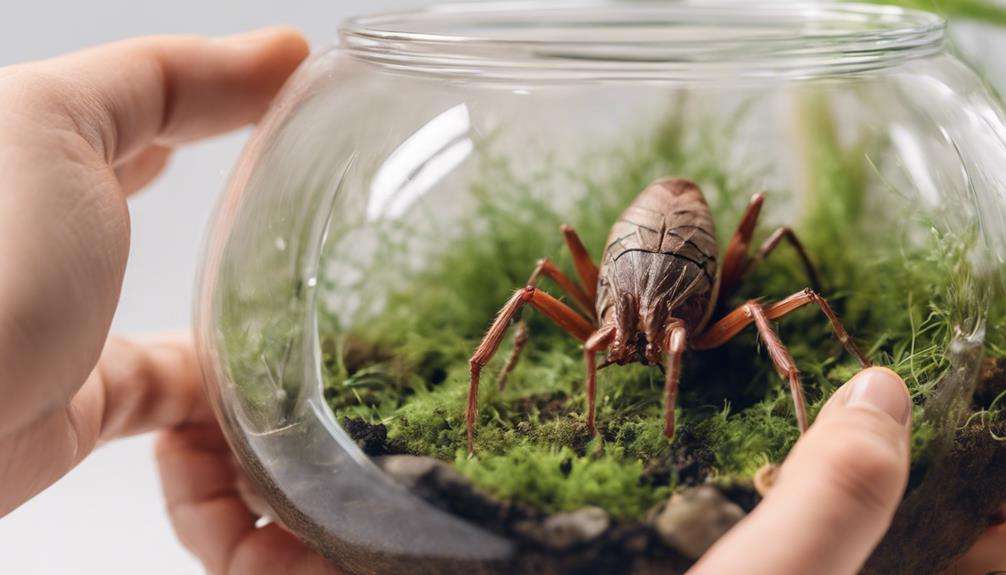
Proper care for pet spiders encompasses maintaining suitable humidity levels in their enclosure to support their health and well-being. Guarantee a humidity level of around 70-80% for most spider species by misting the enclosure regularly.
A suitable diet for your pet spider consists of live insects like crickets, mealworms, or roaches, providing essential nutrients for their survival. It's advisable to avoid handling your pet spider unnecessarily to prevent stress and potential harm.
Regularly clean the spider's enclosure to prevent the growth of mold, mites, or harmful bacteria, ensuring a clean and healthy environment. Monitor your pet spider for any signs of illness or abnormal behavior, such as lethargy or loss of appetite, and promptly seek veterinary care if needed.
Handling and Interaction Guidelines
Maintain a respectful distance from your pet spider to minimize stress and reduce the risk of bites while ensuring its well-being and safety. Spiders aren't like traditional pets that enjoy handling or physical interaction. Handling spiders can be stressful for them and may lead to an increased risk of bites. Interaction with spiders should mainly focus on routine care tasks, such as feeding and maintaining their habitat.
Unlike some pets, spiders don't form bonds with their owners through physical contact. Understanding that proper handling techniques are vital when dealing with spiders to guarantee their safety and well-being. By respecting their need for space and limiting direct contact, you can help keep both yourself and your pet spider safe.
Common Misconceptions About Pet Spiders
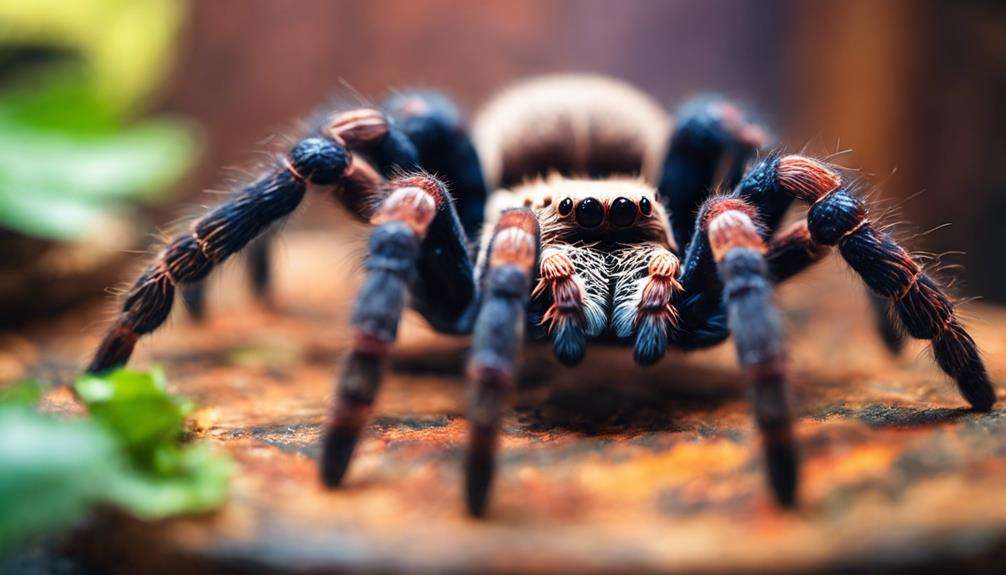
Many misconceptions surround pet spiders, leading to misinformation about their behavior and care requirements. It's important to understand that not all pet spiders, especially tarantulas commonly kept as pets, are venomous. In fact, many species have mild venom that poses little to no threat to humans.
Contrary to popular belief, pet spiders aren't inherently aggressive. They typically only resort to biting when they feel threatened or provoked. The venom of most pet spiders causes reactions similar to a bee sting and isn't considered dangerous.
Handling a pet spider with care and respect is key to minimizing the risk of bites or defensive behavior. Proper research on the specific species you intend to keep is essential for ensuring a safe and enriching experience as a pet owner. Each species has unique care requirements and behaviors, making it essential to be species-specific in your approach to caring for a pet spider.
Frequently Asked Questions
Are Spiders Considered Pets?
Spiders are indeed considered pets by many enthusiasts. They require specific care for aspects like behavior, feeding, handling, habitat, species, health, lifespan, enrichment, and ownership. Proper knowledge and attention are essential for their well-being.
What Is the Point of a Pet Tarantula?
A pet tarantula serves as a unique companion that offers therapeutic benefits through observing their fascinating behaviors. They are low maintenance, quiet companions that provide educational experiences about natural predators. Beautiful species make them exotic yet unconventional pets.
What Spider Is Good for a Pet?
Jumping spiders are great pets due to their active nature and colorful appearance. Wolf spiders are hardy and easy to care for. Orb weavers are fascinating to observe. Huntsman spiders are unique with their massive size.
Are Spiders High Maintenance Pets?
Spiders are low maintenance pets. They require little time, feeding sporadically but surviving well. Their small terrariums suit their solitary nature. Care involves safety handling and considering health. Minimal grooming, no socializing, but potential bond.
Conclusion
Captivating, consider the unique and rewarding experience of owning a pet spider. Despite common misconceptions, these low-maintenance creatures can be fascinating to observe in a small terrarium.
Remember to select the right species, understand their care requirements, and prioritize safety measures. Embrace the opportunity to explore the world of arachnids and discover the wonders they've to offer.
After all, who wouldn't want a window into the captivating world of these intriguing eight-legged companions?
